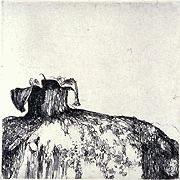Apple of Carthage
Folio of 12 etchings by Sarah Horowitz. 2001
Size: 14 x 10”
Edition of 15 folios SOLD OUT; individual prints available
Apple of Carthage, n. pomegranate, Punica granatum.
The Phoenicians were the first to cultivate the pomegranate. They brought it with them to Carthage which they founded in 814 BCE and thrived until it was destroyed in 146 BCE by the Romans during the last of the Punic Wars. The pomegranate is native to Asia and is found throughout the Mediterranean and Middle East. It is commonly used as a syrup for sweetening as well as a dye. Because of its many seeds it has long been a symbol of fertility. Hebrew tradition describes it as having 613 seeds, the number of laws God gave to Israel. I am intrigued by organic objects, their structures and life cycles. I find the pomegranate particularly arresting, especially the inaccessible seeds within. They are unevenly apportioned into groups which are separated by thin yellow-white tissue. According to the Greek myth, it was of these seeds that Persephone ate, binding her to return yearly to Hades, the underworld. And therefore the living world was condemned to mourning her absence each year while the earth grew cold for three months of winter.
Looking more closely, the irregular skin begins to show more than one first perceives. Some of my pomegranates were striped by red and orange dots, while others were almost solidly red. They hang from trees that grow more like large shrubs, twiggy and multi-stemmed, with their crowns facing down. On the table they wobbled while I drew them; their shapes were not describable by any ordinary geometry. The awkward fruit began to dry out, revealing through the lumps, its seed structure below. I began drawing pomegranates in December of 2000 without any intention of a project greater than the results of my drawings. Individually the pomegranates took on emotion and gesture to become figures, landscapes, and abstractions. The pomegranate became the object, and the subject, its transcendence. Each drawing gave me a new perspective from which to view pomegranates, as well as creating a sense of time. As I drew them they shriveled and darkened. Some dried and therefore were preserved, and others self-destructed, molding and disintegrating. These drawings attempt to capture this cycle of death and life.
Apple of Carthage was designed and printed in Portland, Oregon by Sarah Horowitz on Zecchi paper from Florence, Italy. The text was handprinted in Bodoni by Macy Chadwick of In Cahoots Press. The edition is twenty, of which fifteen copies are enclosed in a box made by Hugh Stump. Each box contains twelve etchings, title page, and colophon.











